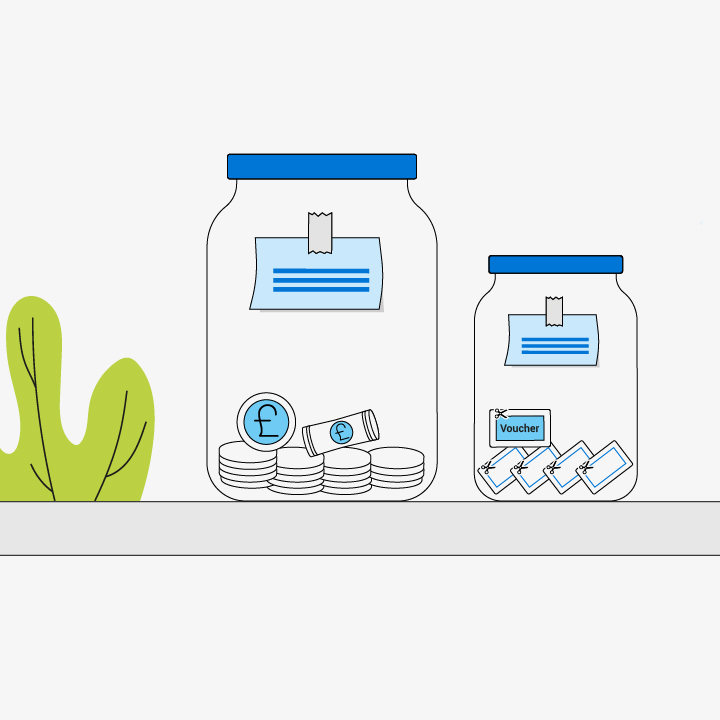Write a budget
Budgeting is a vital way of managing your finances and being in control of your money.

It is worth taking the time to make sure you really understand how much you have coming in, what has to be paid from your income (like rent, mortgage, bills, debts) and what else you are spending.
We’ve put together a four-step plan to help you to write a budget.
If your day-to-day money feels out of control it is worth making sure you do every step, but you don’t have to do them all in one day if it feels too much. Each step will be taking you closer to having a sense of control no matter how small they are.
Step one: Work out what your income and spending really looks like
The first step is getting everything out on the table like receipts, credit card and bank statements and all your bills, so you can see what your finances really look like.
Doing this can help you get your money under control, see if there are any opportunities to save money, save an emergency fund or save for something you really want.
If this is the first time you’ve really looked at your finances and your day-to-day money feels out of control, it can feel overwhelming and scary to even think about doing this, especially if you have more going out than coming in. It may be worse in your mind than it actually is and getting it all down on paper or in a spreadsheet might be surprisingly helpful to ease your worries. Understanding your situation is the first step to taking control.
Step 2: Calculate your current budget
The next step is to use all of this information to work out what you have coming in, what is going out and where that money is going at the moment.
Don’t just think about your monthly bills and spending. Think ahead and include spending that happens less often, like Christmas, birthday presents, beauty products, shoes, clothing, household goods or even holidays.
It is important to be honest about your spending at this stage. If you underestimate your spending there may be fewer opportunities to cut costs or save money.
We’ve got a tool to help you work this out.
Use the MoneyHelper budget calculator to help you think about all of your income and outgoings throughout the year.
The tool has sections for each type of spending and can help you think about different types of spending. You can also add each cost as a daily, weekly, monthly or annual amount and the tool will work everything out for you to show a total summary and a breakdown of where your money goes.
You can email a copy of the completed planner to yourself or download it so you can keep track and play around with different spending.
Step 3: Make changes to your current budget and forecast ahead
You may find that you have more money going out than coming in, don’t despair. You’ll be able to start taking meaningful steps towards getting back in control once you know where everything is going. It doesn’t matter how small those steps are, each one will take you closer to control.
If your current budget is in good shape and you’re able to do all the things you want to do – it may be worth monitoring from time to time, or coming back to your budget if anything changes. You can download a copy of your budget plan calculator or email it to yourself so it’s easier to make adjustments next time.
If you’re spending more than your income and it feels out of control, or your looking to cut costs to pay off your debts more quickly, save for something or just make sure you aren’t spending more than you have to – it’s time to give your budget an MOT.
You can use the calculator, or your downloaded version, to play around with cutting different types of spending or adding in savings to see how this impacts your overall budget.
It's not easy to increase the amount of money you have coming in each month but you can gain more control over what goes out. For example, you could make savings by shopping around, switching utility providers or paying your debts off in a different order.
- Find out more about managing your debt.
- If you’re in a debt emergency, find out more about the free help available to you.
- Find out more about cutting costs.
- Find out more about saving an emergency / rainy day fund.
You may not be able to make all your changes at once. Take your time and tackle each area of spending in turn. You may even find that you need to adjust your budget slowly over a period of months to get things back under control.
Once you’ve found a budget and plan that works for you, stick to it.
This may mean allowing yourself a specific amount each week or month to live on after all your bills have been paid, and no more – even if that means cutting back for a period to reign in your spending.
If you’re putting aside any savings, you could transfer this out to your savings as soon as you are paid so that it doesn’t become part of your spending by accident. If you need to, you can always dip into your savings and then top it back up again later.
There may be set backs along the way, but you should be more in control than you were at the beginning. And remember you’re taking lots of positive steps, make time to celebrate your achievements along the way.
Step 4: Monitor your budget
Writing a budget is not a once-and-done. If you’ve used the calculator, download your plan and save it so you can come back to it regularly and monitor how you’re doing against it.
You could also try setting yourself reminders to check your budget, review your bills (especially if you’re still in a contract and can’t switch yet) and see how you’re doing against your plan.
Extra tips
MoneyHelper is part of the Money and Pensions Service.
More in this section
 Cutting costs >
Cutting costs >
We’re all probably a little guilty of not shopping around for the best deals from time-to-time. We have some tips for cutting costs around key spending areas.
 Income tax explained >
Income tax explained >
Here we cover the basics of income tax and how tax might be paid on your pension income or savings interest.
